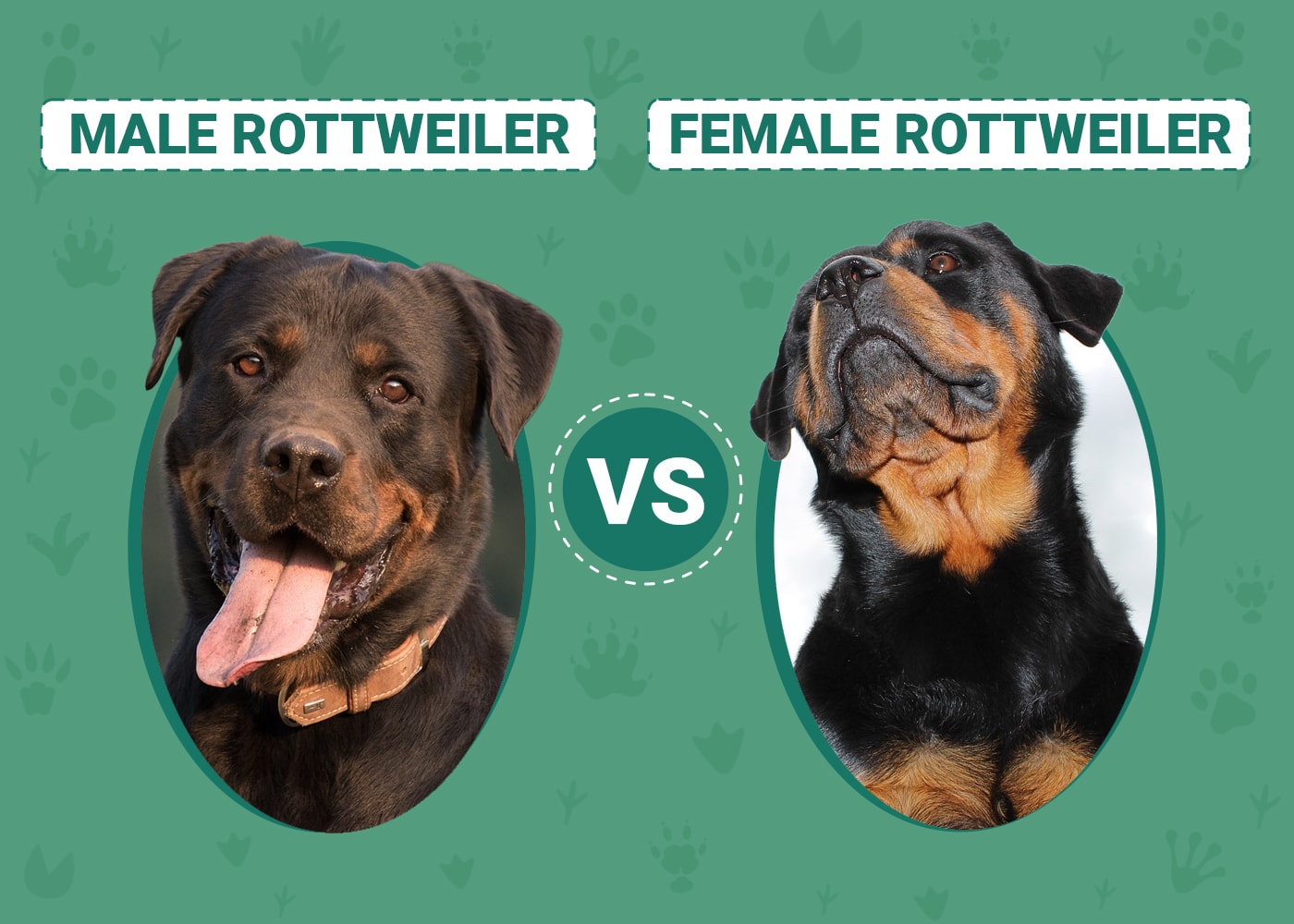Click to Skip Ahead
Rottweilers are large, powerful dogs that are somewhat intimidating at first glance, but in reality, they are sweet, loving pooches that make great family dogs. Still, having such a powerful dog is a massive responsibility, and these dogs can be dangerous without the proper training and socialization.
If you’ve decided that a Rottweiler is the right dog for you, you’ll need to decide whether to get a male or female is. It’s important to remember that all dogs are unique individuals, and as such, there are few certainties when it comes to the sexes. Still, there are a few differences to be aware of. In the following article, we look at these differences to help you decide which is best for you.

Visual Differences

At a Glance
- Average height (adult): 24–27 inches
- Average weight (adult): 95–135 pounds
- Average height (adult): 22–25 inches
- Average weight (adult): 80–100 pounds
Rottweiler 101
Rottweilers were initially developed in Germany for driving cattle and pulling carts and were one of the first breeds to be used in the police force and military. These dogs are popular family dogs nowadays and make formidable guard dogs and family protectors. Rottweilers are calm, collected, and confidant dogs with a natural instinct to protect their families and aloofness toward strangers, but they are rarely aggressive unless provoked.
They are highly intelligent dogs that are easily trained, but without proper training, they can easily become overprotective, which can quickly become problematic. This is why Rotties need owners with a firm but gentle hand. You’ll need to quickly establish yourself as the leader of the pack; otherwise, your Rottweiler will take the position first!
That said, Rottweilers are not inherently aggressive or vicious animals, and if they’re trained properly, they are among the most gentle and loving dogs around, making them ideal family pooches. Like many other powerful breeds that are often used in military or police work, Rottweilers are largely misunderstood dogs that are undeserving of their vicious reputation. These large, powerful dogs are gentle giants overall; they just need direction and consistent training from a gentle and confident owner to guide them.
Male Rottweiler Overview

Personality / Character
In general, male dogs are known for typical “male” behaviors like marking territory or aggression, but this is not true of all males and certainly not when it comes to Rottweilers. Male Rotties are highly affectionate dogs and loyal protectors and will only act aggressively when provoked or in defense of their family. They can display dominant behavior at times, though, and may keep testing their boundaries throughout their early years, a trait that you’ll need to keep a close eye on.
Male Rotties are also known for attaching themselves strongly to one member of the family, usually the person who feeds and trains them, although they are still affectionate and loyal to other family members too.
Training
Since male Rottweilers mature slightly later than females and have more of a tendency toward protective and territorial behavior, training males can be more tricky than females. You’ll need to exercise patience and make training sessions consistent in order to be successful, but with the Rottie’s intelligence and loyalty, they are usually not difficult to train.
Health & Care
When it comes to health and care, there are almost no differences between male and female Rottweilers, as both can suffer from the same genetic or otherwise lifestyle-related health issues. That said, neutering males can help calm their territorial and dominant tendencies and help stop them from marking their territory. Neutering males is highly recommended by most dog experts unless you intend on breeding.
- Prostate cancer
- Aortic stenosis
- Hip and elbow dysplasia
- Cardiomyopathy
- Progressive retinal atrophy
- Entropion
- Cruciate ligament rupture
Breeding
Males generally reach full sexual maturity at 16–25 months old but are fertile from as young as 6 months old. That said, you should always wait until a male is sexually mature before breeding, and most experts agree that you should wait until your male is at least 2 years old before breeding. Also, you should not breed a male that’s older than 10 years, as they will have decreased quality of sperm.
- Large size
- Protective
- Not prone to mood swings
- Playful
- Inexpensive to neuter
- More prone to aggression
- Territory marking
- Harder to train than females
Female Rottweiler Overview

Personality / Character
Female Rotties are generally more aloof than males, with a more independent personality. Females are far less attention-seeking than males but are still affectionate and loving, just in a less needy manner. They are also less likely to get attached to one member of the family, and generally, they show the same level of loyalty and affection toward the whole family.
Training
Since females mature faster than males, they are also usually easier to train. They have a calm, cool temperament that enables them to focus on training for longer periods than males, and they are not as easily distracted. They are also less inclined toward dominance than males, so they are more likely to follow commands. Females are still perfectly capable police and military dogs, though, and can make wonderful guard dogs too, despite their comparative lack of aggression, dominance, and territorial behavior.
Health & Care
There are few health differences between male and female Rottweilers, but females can be prone to health problems if they are not spayed. They will have hormonal fluctuations that can cause them to be moodier in general, and they will go through the normal heat cycles. Unless you intend on breeding, most experts recommend spaying females to avoid unwanted pregnancies and for their overall health.
- Ovarian cysts
- Mammary cancer
- Aortic stenosis
- Hip and elbow dysplasia
- Cardiomyopathy
- Progressive retinal atrophy
- Entropion
- Cruciate ligament rupture
Breeding
Like males, it’s best to wait at least 2 years before breeding your female Rottweiler or at least wait until her second heat. Females tend to reach full sexual maturity at around 16 months old, but this is not a good time to begin breeding because it can cause confusion and stress for such a young mother. Additionally, females should not be bred after the age of 8, as this can put a great deal of strain on her body and even result in possible birth defects due to the deterioration of the quality of her eggs.
- Smaller in size
- Less prone to aggression
- Less territorial
- Not as attention-seeking as males
- Easy to train
- Expensive to spay
- Prone to moodiness
- Not as affectionate as males

Which Is Right for You?
Both male and female Rottweilers make wonderful companions, both for singles and for families with children. It’s difficult to make generalizations about male and female dogs, as certain so-called male traits may be present in females and vice versa. Many of the aforementioned aspects are largely anecdotal, other than size. That said, there are certainly a few differences to take into consideration, especially when considering neutering or spaying. If you have a dog at home already, it may be better to go with a Rottweiler of the opposite sex to avoid any territorial behavior.
Is a male or female Rottweiler the right choice for you? That’s a question that only you can answer, and hopefully, we’ve provided you with enough information to help you make your decision. Either way, you’re sure to end up with a wonderful, intelligent, loyal, and playful pooch!
- Related read: 6 Best Shampoos for Rottweilers – Reviews & Top Picks
Featured Image Credit: 1 -K L, Pixabay, 2 – Ricantimages, Shutterstock












